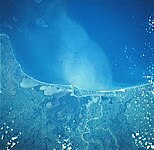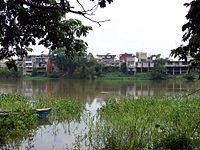Papaloapan River
Template:Geobox The Papaloapan River (Template:Lang-es) is one of the main rivers of the Mexican state of Veracruz. Its name comes from the Nahuatl papaloapan meaning "river of the butterflies".[1]
Juan de Grijalva's 1517 expedition discovered the river, naming it Rio de Alvarado.[2]: 34 The Papaloapan rises in the Sierra Madre Oriental on the border between the states of Veracruz and Oaxaca. It is formed where the Santo Domingo River and the Valle Nacional River join to the southwest of San Juan Bautista Tuxtepec in Oaxaca. The Tonto River is another major tributary. The Papaloapan meanders for 122 km (76 mi) in a northeasterly direction through the coastal plain before draining into Alvarado lagoon.[3] The river basin covers 46,517 km2 (17,960 sq mi), the second largest in Mexico, and contains 244 municipalities with a population of about 3.3 million people.[4] The cities of San Juan Bautista Tuxtepec and Tlacotalpan (Veracruz) are situated on the banks of the Papaloapan.
In the past the Papaloapan river basin was subject to frequent flooding, with the damage sometimes compounded by cyclones. A particularly severe flood in September 1944 covered 470,000 hectares (1,200,000 acres), with great loss of life and property. The Miguel Alemán Dam on the Tonto river reduced the problem, but further floods occurred after it had been completed in 1955. A flood in 1958 covered 195,000 ha (480,000 acres) and one in 1969 covered 340,000 ha (840,000 acres). Meanwhile, the drainage capacity of the Papaloapan river was being reduced by silt carried by the Santo Domingo river. Construction of the Cerro de Oro Dam in 1989 on the Santo Domingo river reduced the extent of floods to a manageable level.[5]
The states of Oaxaca and Veracruz are cooperating in developing the river basin. Plans include irrigation to improve agricultural production, promotion of forestry and fish farming and improvements to roads and river navigation. The planned projects will be designed to avoid ecological damage.[4] Environmental damage has been the subject of considerable study.[6]
See also
-
Satellite picture of the Papaloapan River ending at the Gulf of Mexico
-
The Papaloapan at Tuxtepec
-
View of the river
-
Papaloapan river in front of Carlos A. Carrillo, Veracruz.
-
Papaloapan River in front of Cosamaloapan
References
- ^ Brasseur de Bourbourg, Charles Étienne (1860). "Cartas para servir de introducción a la historia primitiva de las naciones civilizadas de la América Septentrional". Boletín de la Sociedad Mexicana de Geografía y Estadística. VIII: 336.
- ^ Diaz, B., 1963, The Conquest of New Spain, London: Penguin Books, ISBN 0140441239
- ^ "Papaloapan River". Encyclopædia Britannica. Retrieved 2010-07-03.
- ^ a b Robin Brundell (April 28, 2006). "State governors agree on actions to develop Papaloapan river basin - Mexico". Business News Americas. Retrieved 2010-07-03.
- ^ Gerardo Cruickshank (1972). "Some Problems of the Papaloapan River Basin" (PDF). Proceedings of University Seminar on Pollution and Water Resources. Columbia University. Retrieved 2010-06-30.
- ^ Patrick H. Cosby, "Leviathan in the Tropics: A postcolonial environmental history of the Papaloapan Projects in Mexico." PhD diss. University of Florida 2011.
18°42′N 95°38′W / 18.700°N 95.633°W





